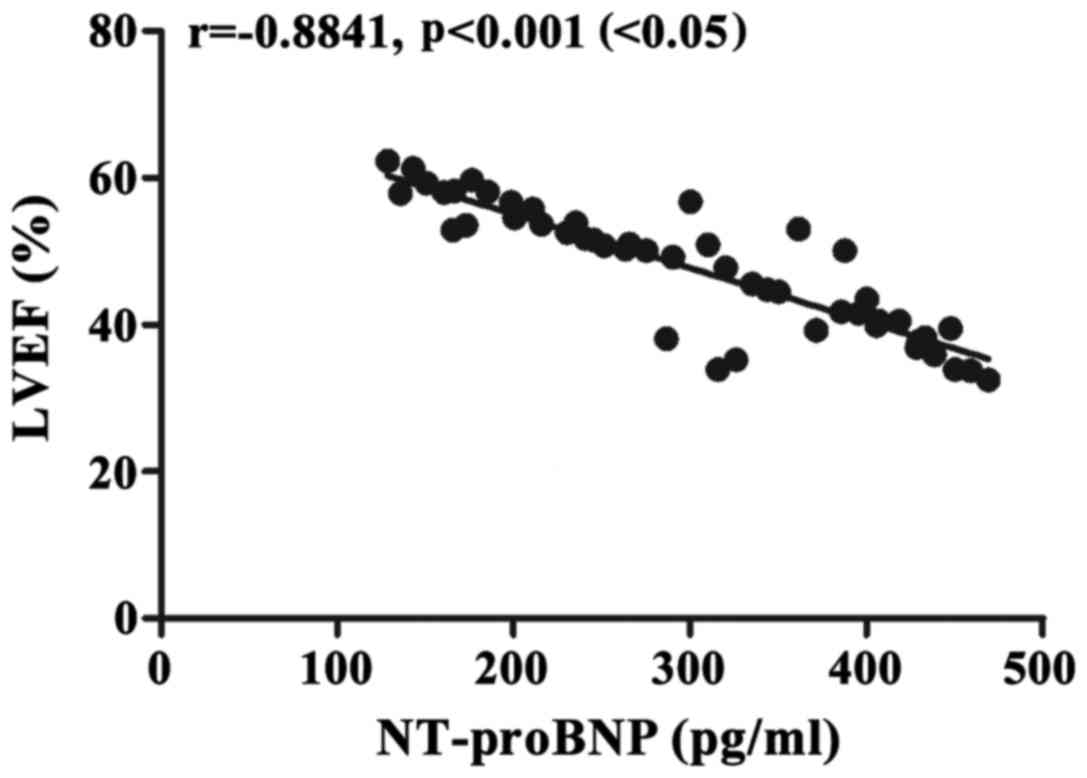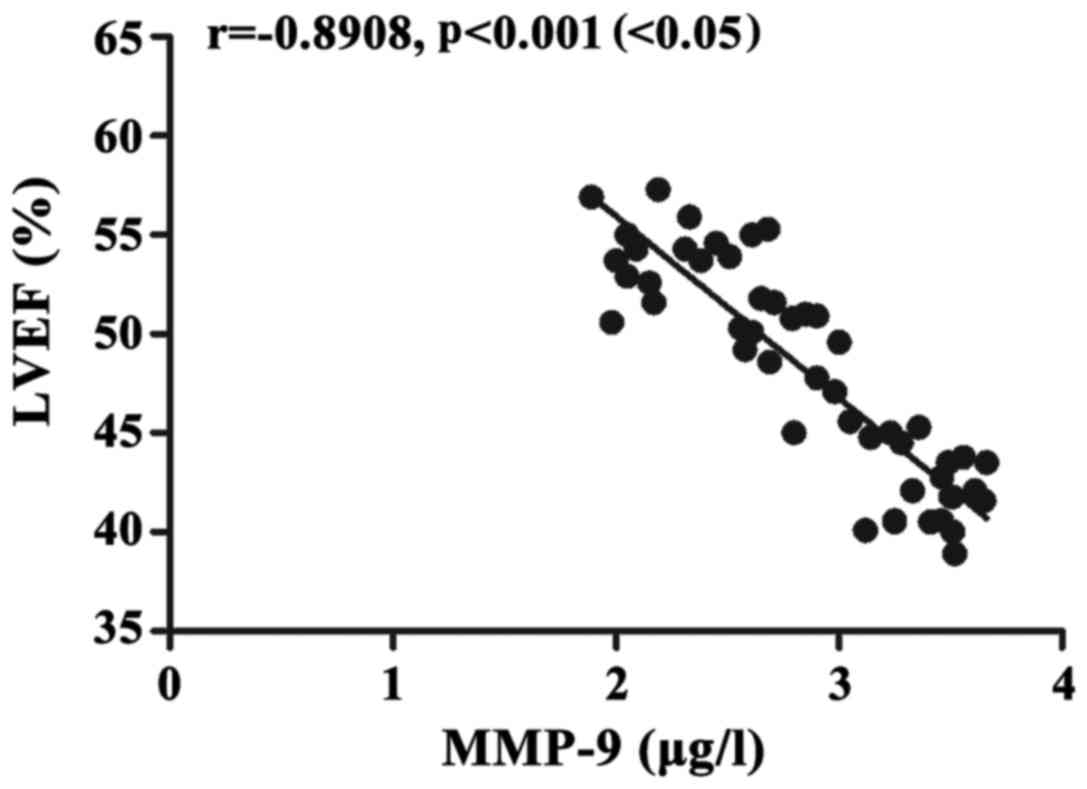|
1
|
Isah IA, Sadoh WE and Iduoriyekemwen NJ:
Usefulness of amino terminal pro-B-type natriuretic peptide in
evaluating children with cardiac failure. Cardiovasc Diagn Ther.
7:380–388. 2017. View Article : Google Scholar : PubMed/NCBI
|
|
2
|
Raedle-Hurst T, Mueller M, Meinitzer A,
Maerz W and Dschietzig T: Homoarginine-A prognostic indicator in
adolescents and adults with complex congenital heart disease? PLoS
One. 12:e01843332017. View Article : Google Scholar : PubMed/NCBI
|
|
3
|
Darkner S, Goetze JP, Chen X, Henningsen
K, Pehrson S and Svendsen JH: Natriuretic propeptides as markers of
atrial fibrillation burden and recurrence (from the AMIO-CAT
Trial). Am J Cardiol. 120:1309–1315. 2017. View Article : Google Scholar : PubMed/NCBI
|
|
4
|
Jiang R, Zhao QH, Wu WH, Zhang R, Yuan P,
Gong SG, He J, Luo CJ, Qiu HL, Wang L, et al: Efficacy and safety
of a calcium sensitizer, levosimendan, in patients with right heart
failure due to pulmonary hypertension. Clin Respir J. 12:1518–1525.
2018. View Article : Google Scholar : PubMed/NCBI
|
|
5
|
Yu J, Oh PC, Kim M, Moon J, Park YM, Lee
K, Suh SY, Han SH, Byun K, Ahn T, et al: Improved early risk
stratification of patients with ST-segment elevation myocardial
infarction undergoing primary percutaneous coronary intervention
using a combination of serum soluble ST2 and NT-proBNP. PLoS One.
12:e01828292017. View Article : Google Scholar : PubMed/NCBI
|
|
6
|
Yan AT, Yan RT, Spinale FG, Afzal R,
Gunasinghe HR, Arnold M, Demers C, McKelvie RS and Liu PP: Plasma
matrix metalloproteinase-9 level is correlated with left
ventricular volumes and ejection fraction in patients with heart
failure. J Card Fail. 12:514–519. 2006. View Article : Google Scholar : PubMed/NCBI
|
|
7
|
Vorovich EE, Chuai S, Li M, Averna J,
Marwin V, Wolfe D, Reilly MP and Cappola TP: Comparison of matrix
metalloproteinase 9 and brain natriuretic peptide as clinical
biomarkers in chronic heart failure. Am Heart J. 155:992–997. 2008.
View Article : Google Scholar : PubMed/NCBI
|
|
8
|
Raphael C, Briscoe C, Davies J, Whinnett
Ian Z, Manisty C, Sutton R, Mayet J and Francis DP: Limitations of
the New York Heart Association functional classification system and
self-reported walking distances in chronic heart failure. Heart.
93:476–482. 2007. View Article : Google Scholar : PubMed/NCBI
|
|
9
|
Chang KW, Fox S, Mojaver S and Maisel AS:
Using biomarkers to guide heart failure management. Expert Rev
Cardiovasc Ther. 15:729–741. 2017. View Article : Google Scholar : PubMed/NCBI
|
|
10
|
Felker GM, Anstrom KJ, Adams KF, Ezekowitz
JA, Fiuzat M, Houston-Miller N, Januzzi JL Jr, Mark DB, Piña IL,
Passmore G, et al: Effect of natriuretic peptide-guided therapy on
hospitalization or cardiovascular mortality in high-risk patients
with heart failure and reduced ejection fraction: A randomized
clinical trial. JAMA. 318:713–720. 2017. View Article : Google Scholar : PubMed/NCBI
|
|
11
|
Dai Y, Yang J, Takagi A, Konishi H,
Miyazaki T, Masuda H, Shimada K, Miyauchi K and Daida H:
In-hospital and long-term outcomes of congestive heart failure:
Predictive value of B-type and amino-terminal pro-B-type
natriuretic peptides and their ratio. Exp Ther Med. 14:1715–1721.
2017. View Article : Google Scholar : PubMed/NCBI
|
|
12
|
Clerico A, Zaninotto M, Passino C and
Plebani M: New issues on measurement of B-type natriuretic
peptides. Clin Chem Lab Med. 56:32–39. 2017. View Article : Google Scholar : PubMed/NCBI
|
|
13
|
Mozzini C, Di Dio Perna M, Pesce G, Garbin
U, Pasini Fratta AM, Ticinesi A, Nouvenne A, Meschi T, Casadei A,
Soresi M, et al: Lung ultrasound in internal medicine efficiently
drives the management of patients with heart failure and speeds up
the discharge time. Intern Emerg Med. 13:27–33. 2018. View Article : Google Scholar : PubMed/NCBI
|
|
14
|
Kang CK, Pope M, Lang CC and Kalra PR:
Iron deficiency in heart failure: Efficacy and safety of
intravenous iron therapy. Cardiovasc Ther. 35:59–62. 2017.
View Article : Google Scholar
|
|
15
|
Shou X, Lin J, Xie C, Wang Y and Sun C:
Plasma IL-37 elevated in patients with chronic heart failure and
predicted major adverse cardiac events: A 1-year follow-up study.
Dis Markers. 2017:91340792017. View Article : Google Scholar : PubMed/NCBI
|
|
16
|
Iacoviello L, Bonaccio M, Di Castelnuovo
A, Costanzo S, Rago L, De Curtis A, Assanelli D, Badilini F, Vaglio
M, Persichillo M, et al: Moli-sani study Investigators: Frontal
plane T-wave axis orientation predicts coronary events: Findings
from the Moli-sani study. Atherosclerosis. 264:51–57. 2017.
View Article : Google Scholar : PubMed/NCBI
|
|
17
|
Luedde M, Winkler T, Heinsen FA, Rühlemann
MC, Spehlmann ME, Bajrovic A, Lieb W, Franke A, Ott SJ and Frey N:
Heart failure is associated with depletion of core intestinal
microbiota. ESC Heart Fail. 4:282–290. 2017. View Article : Google Scholar : PubMed/NCBI
|
|
18
|
Toma M, Mak GJ, Chen V, Hollander Z,
Shannon CP, Lam KKY, Ng RT, Tebbutt SJ, Wilson-McManus JE,
Ignaszewski A, et al: Differentiating heart failure phenotypes
using sex-specific transcriptomic and proteomic biomarker panels.
ESC Heart Fail. 4:301–311. 2017. View Article : Google Scholar : PubMed/NCBI
|
|
19
|
Darche FF, Baumgärtner C, Biener M,
Müller-Hennessen M, Vafaie M, Koch V, Stoyanov K, Rivinius R, Katus
HA and Giannitsis E: Comparative accuracy of NT-proBNP and
MR-proANP for the diagnosis of acute heart failure in dyspnoeic
patients. ESC Heart Fail. 4:232–240. 2017. View Article : Google Scholar : PubMed/NCBI
|
|
20
|
Medvedeva EA, Berezin II and Shchukin YV:
Galectin-3, markers of oxidative stress and renal dysfunction in
patients with chronic heart failure. Kardiologiia. 57:46–50.
2017.(In Russian). PubMed/NCBI
|
















